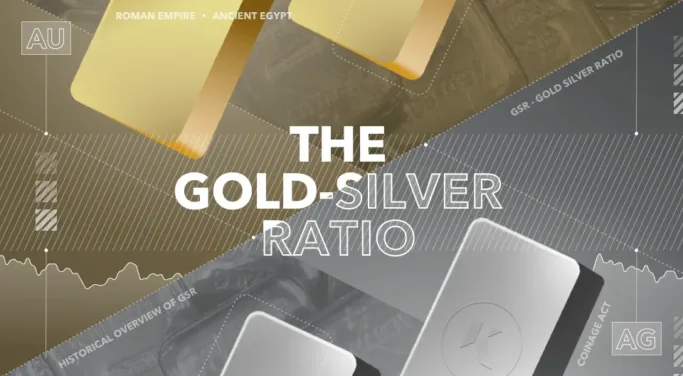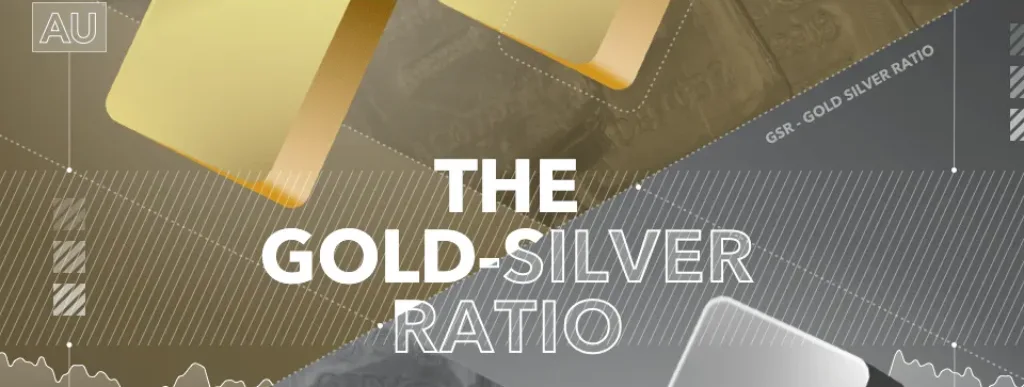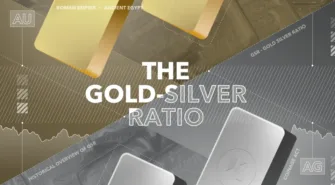The gold-silver ratio (“GSR”) measures the number of ounces of silver that you can buy with one ounce of gold.
The GSR is a useful metric to measure the value of silver relative to the price of gold – a metric which continues to influence investment decisions today.
Analysts also use the GSR to gauge the general level of market interest in gold and silver as an investment and wealth preservation asset.
Historical Overview of the Gold-Silver Ratio
Historically, the GSR fluctuated between 10 and 15, though the ratio was as low as 2.5 in ancient Egypt.
Since ancient Rome, miners have unearthed about eight ounces of silver for every ounce of gold on an annual basis.
During the times of the Roman Empire, the government fixed the GSR at 12 to one, but over the centuries, the metric has remained at around 15 or lower.
In 1792, Congress passed the first Coinage Act and fixed the GSR at 15, which reflected the ratio established by the global market for gold and silver.
Shortly thereafter, the world market ratio drifted up to 15.5 and the U.S. Congress then bumped up the ratio to 16 in 1834. At the same time, Congress fixed the price of gold at $20.67.
The chart below from TradingView shows the gold-silver ratio from 1700 to the present day:
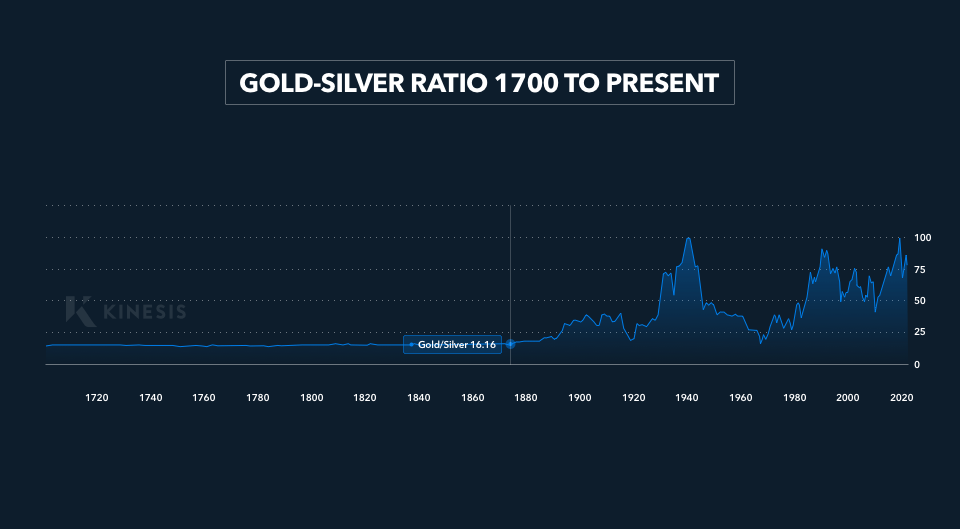
After 1873, the gold standard became the basis for the international monetary system.
As you can see on the chart, the GSR began to drift marginally higher starting in 1874. The discovery of the Comstock Lode in Nevada led to record U.S. silver output. This, in turn, depressed the price of silver and caused the GSR to rise.
Factors That Influence the Gold-Silver Ratio
Between 1920 and the present, the GSR became highly volatile relative to the centuries preceding 1920, with the GSR fluctuating between 25 and 100. In my opinion, the primary cause of this volatility was the gradual drift of the world to an unbacked, fiat currency system. The U.S. Government formed the Federal Reserve in 1913 and it was at this point that the world began to move away slowly from a strict gold standard. A fixed price of gold continued to back the global monetary system until 1971, after which time, the world transitioned to fiat currency.
The flaws inherent in fiat currency are a major factor in gold’s continued popularity. That’s according to cryptocurrency writer and expert, Sean Dickens:
“The ability to print money out of thin air has consequences. Fiat is very easy to control and does have many advantages over gold-backed assets.
“The diminishing value of fiat, along with some other problems surrounding it, should not be underestimated. Some entities could manipulate its circulation, which could lead to an economic disaster.”
The impact of economic supply and demand on GSR
A factor directly influencing the price of silver – more so than gold – is economic supply and demand.
The GSR fluctuates in cycles that correlate with economic cycles. Since Industrial uses account for 70% of the use of mined silver, the demand for silver often ebbs and flows with the economic cycle. This, in turn, translates into cyclical price fluctuations for silver as well as the GSR.
Investor perceptions and how that affects GSR
The economic climate also affects the way investors approach gold. Many investors believe that gold is worth investing in due to its historical stability and potential for growth. It has particular allure as a hedge against inflation and economic uncertainty.
In differing interest rate environments, gold is a preferred way for many investors to diversify risk. Over the long term, it offers the potential to maintain and build on its value, especially during economic downturns.
Part of this perception is because of gold’s historic use as money. Central banks and, historically, institutions such as coin mints have hoarded gold in economic downturns.
This demand affects the amount of gold in supply, pushing up the price and thereby influencing the GSR. It also reinforces gold and silver as prudent long-term investments.
How future trading affects gold and silver prices
Some argue that the “financialisation” of gold and silver trading also caused greater price volatility. While I can trace trading in silver futures back to 1963, gold futures were introduced in 1974.
In the chart above, you can see that the last time the GSR traded as low as 25 was 1971 when the world went completely off the gold standard.
Since 1974, after gold futures trading commenced on the Comex, the GSR has spent most of its time above 50 and has averaged 60.
Futures trading can, to an extent and over short periods of time, dictate gold and silver price movements. When the spot price of gold declines, the price of silver declines more on a percentage basis.
This is because the silver market is smaller and more volatile than gold. This also explains the higher average ratio level of the GSR since 1974, particularly when the prices of both are declining.
Recent trends in the GSR
The chart below shows the GSR weekly since 2000. This was the year when the 20-year precious metals bear market began to bottom and launch into the ongoing secular bull market:
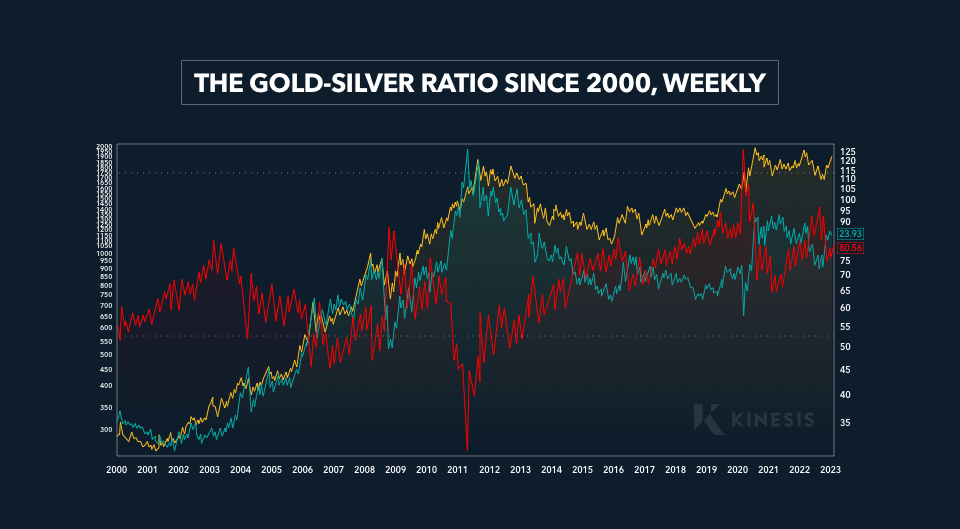
How to Trade the Gold-Silver Ratio
Given the cyclical pattern of the GSR shown in the chart above, it may be tempting to employ trading and/or investing strategies based on the relative level of the GSR and the relative price differential between gold and silver. The black horizontal lines show the “90th percentile” levels for highs and lows in the GSR since 2006.
The black horizontal lines show the “90th percentile” levels for highs and lows in the GSR since 2006.
Longer-term investors focused on physical ownership and not short-term gain use GSR differently. They see this as an indicator of when they should invest in silver and gold.
Let’s observe the historical pattern of the GSR since 2006. When GSR is above the upper black line, silver is relatively cheap compared to gold, which suggests a buying opportunity for silver. The reverse is true when the GSR is at or below the lower black line boundary.
When GSR is between the two lines, that’s a call individual investors have to make. The relative premiums for minted gold and silver might influence investors’ decisions either way.
If you want to buy physical gold and silver and trade the GSR, consider a precious metals account with Kinesis. The Kinesis platform makes it easy and low-cost to invest in and trade allocated, physical gold and silver.
With Kinesis, you own the metal in your account and you can request physical delivery at any time. Add to this, the platform offers traders low fees and the ability to easily shift your relative portfolio percentage weighting of gold and silver. For a more detailed look at how to trade the gold-silver ratio, see this article here.
Dave Kranzler is a hedge fund manager, precious metals analyst and author. After years of trading expertise build-up on Wall Street, Dave now co-manages a Denver-based, precious metals and mining stock investment fund.
This publication is for informational purposes only and is not intended to be a solicitation, offering or recommendation of any security, commodity, derivative, investment management service or advisory service and is not commodity trading advice. This publication does not intend to provide investment, tax or legal advice on either a general or specific basis. The opinions expressed in this article, do not purport to reflect the official policy or position of Kinesis.
Read our Editorial Guidelines here.

